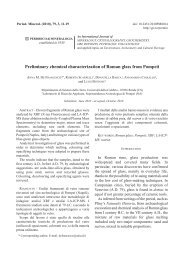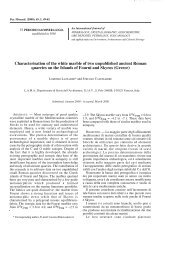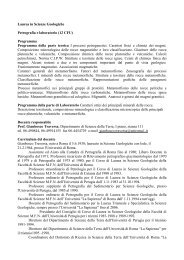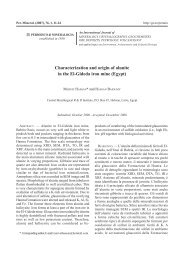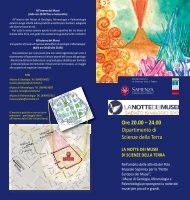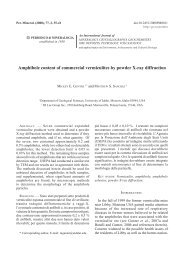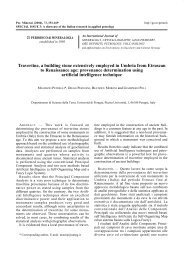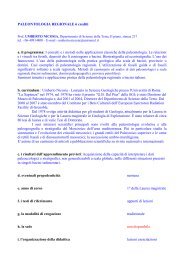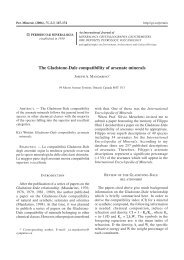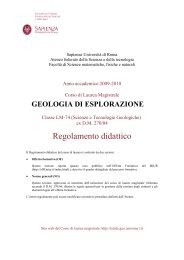Full text - Dipartimento di Scienze della Terra - Sapienza
Full text - Dipartimento di Scienze della Terra - Sapienza
Full text - Dipartimento di Scienze della Terra - Sapienza
- No tags were found...
You also want an ePaper? Increase the reach of your titles
YUMPU automatically turns print PDFs into web optimized ePapers that Google loves.
Analcimization processes in the pyroclastic rocks from Phlegraen Fields (Southern Italy)... 263<br />
welded and coarse-grained scoria with<br />
decimeter-sized ballistic bombs and blocks.<br />
Scoriaceous fragments are arranged in <strong>di</strong>screte<br />
and overlain layers formed during the build up<br />
of the cone. Only few beds are connected to<br />
mass-flow processes resulting from<br />
avalanching and rolling of scoria deposits.<br />
From the Fondo Riccio cone eleven <strong>di</strong>screte<br />
layers were sampled from bottom to top (Fl<br />
Fl1 samples). Nearly all the layers range from<br />
40 to 80 cm in thickness with the exception of<br />
the seventh layer (F7) which is 4 m thick. Only<br />
one layer (F4) is mainly formed by a finegrained<br />
vitric tuff and it shows glassy<br />
fragments with apparent <strong>di</strong>fferences in the<br />
vesciculation degree.<br />
Bulk rock composition (major and trace<br />
elements) was determined by X-ray<br />
fluoroscence spectrometry (Philips PW 1400<br />
XRF spectrometer), using pressed powder<br />
pellets, accor<strong>di</strong>ng to the method of Franzini et<br />
al. (197 5) and Leoni and Sai tta (197 6).<br />
International standards were used for<br />
calibration; the precision for major elements<br />
are usually estimated to be below 3%. Mg and<br />
N a were determined by atomic absorption<br />
spectrophotometry (Perkin-Elmer model 21 00)<br />
and analytical precision is within ± 1%. The<br />
analytical precision is better than 5% for Sr, Zr<br />
and Ba and better than 10 % for other trace<br />
elements. REE were determined by ICP-MS at<br />
CRPG, Nancy, France (Govindarju and<br />
Mevelle, 1987).<br />
The analcime contents were measured,<br />
accor<strong>di</strong>ng to Parker (1978), using a Philips PW<br />
1730 X-ray <strong>di</strong>ffractometer (40 kV, 30 mA)<br />
with Ni-filtered Cuka ra<strong>di</strong>ation. In order to<br />
better define the analcime type, thermal<br />
analysis (DT A, TG and DTG) was performed<br />
using a Netzsch Geratebau GMBH instrument<br />
with a heating rate of 1 0°C/min between 20-<br />
10000C.<br />
Scanning electron microscope analyses were<br />
made using a Cambridge Stereoscan model 250<br />
MK3 equipped with EDS Link model AN<br />
10/55 S. Microprobe analyses were carried out<br />
on automated ARL SEMQ (C.N.R. Cagliari)<br />
(accelerating voltage 15 k V; beam current 20<br />
nA). Natural silicates and oxides were used as<br />
standard materials. On-line correction for drift,<br />
dead-time and background was applied to the<br />
raw data. All data were corrected using ZAF<br />
FLS program.<br />
Strontium separation was carried out by<br />
<strong>di</strong>ssolution of samples in HF and HC104 acids<br />
and by passage through a 50 x 8 (200-400<br />
mesh) cation exchange resin. 87SrJ86Sr ratios<br />
were measured on a VG Isomass 54E mass<br />
spectrometer (CNR, Roma). For the NBS 987<br />
SrC03 standard, the mean value of 0. 71024 ±<br />
0.00002 was achieved, with a standard<br />
deviation of 0.00001 (15 measurements).<br />
RESULTS<br />
Classification and petrographic notes<br />
20<br />
Ne<br />
fs<br />
Peralkaline<br />
• phonolitic<br />
10 ...<br />
trachytes<br />
···---- ---· -- ·--<br />
In the present paper a classification based on<br />
CIPW normative composition is used. In the<br />
Differentiation Index (D.I.) vs Nepheline (Ne)<br />
classification grid (Armienti et al., 1983) the<br />
investigated rocks fall into the following five<br />
main fields: 1) shoshonites, 2) latites, 3)<br />
trachytes, 4) alkali trachytes and 5) peralkaline<br />
phonolitic trachytes (fig. 1).<br />
All the scoriaceous fragments are<br />
subrounded, dark -coloured and homogeneous<br />
in hand samples. They are aphyric to sub-<br />
Shoshonites Latites • Trachytes Alkalitrachytes<br />
•til<br />
•<br />
# f<br />
1'-<br />
,;J' 4 A<br />
D.l.<br />
:.<br />
.1.<br />
0<br />
40 50 60 70 80 90 100<br />
Fig. 1 - Plot of D.J. vs Ne (%) for Minopoli ( + ), Fondo<br />
Riccio (•), Concola (0), Mt. Santa Teresa (..t.), Senga (X),<br />
and Mt. Nuovo (0) scoriaceous fragments. D.l.=<br />
Ab+Or+Ne+Lc. Classification <strong>di</strong>agram mo<strong>di</strong>fied from<br />
Armienti et al. (1983).



